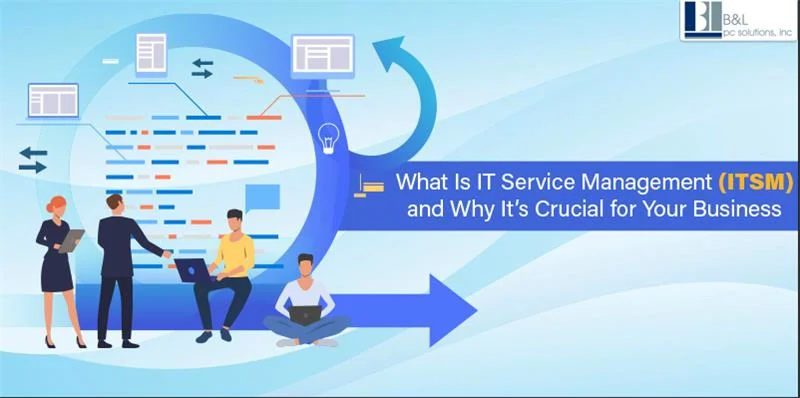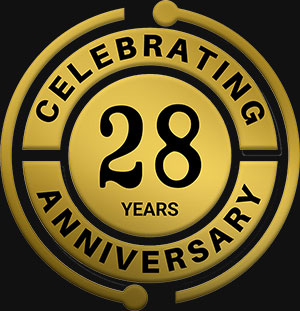With the fast world of modern digital processing, businesses depend on technology more than ever. But the administration of IT systems and providing consistent, reliable service isn’t that simple. That’s where IT Service Management (ITSM) comes in.
ITSM is not tech support but the strategic design, delivery, and management of IT services to meet business objectives. Whether you're a Small startup or a long-established enterprise, a properly integrated ITSM framework ensures you get value for every dollar invested in your technology.
At B&L PC Solutions, we help businesses simplify their IT operations and increase efficiency with innovative ITSM solutions. In this blog, we explain everything you have always wanted to know about ITSM, from what it is to why it counts and what steps to follow to implement it correctly.
What is IT Service Management (ITSM)?
IT Service Management (ITSM) implies all activities unrelated to IT network architecture, delivery, support, and IT lifecycle management. Unlike traditional IT support services, which act instead of providing a solution, ITSM proactively and systematically seeks IT as a service.
Standard ITSM Practices Include:
- Incident Management: Resolving unplanned interruptions quickly.
- Problem Management: Identifying and eliminating root causes.
- Change Management: Managing updates and changes without operational disruption.
- Asset Management: Tracking and managing hardware/software.
- Service Request Management: Processing user requests (password resets, software installations).
- Knowledge Management: Developing documentation for consistency and efficiency.
Example: When a company’s email server crashes, ITSM tools create a ticket, assign it to the proper technician, and track it to resolution, while documenting for reference later.
Why IT Service Management Matters for Businesses?
When businesses do not have adequate ITSM, problems become rampant, such as sluggish response time, unequal service, and communication gaps among departments. That is how ITSM differs:
- Makes Response Time Better: Problems are readily solved through structured workflows.
- Added Value to Service Quality: Processes are determinable and measurable for efficiency.
- Aligns IT with Business Goals: Once IT and IT goals are aligned with Business goals, services are developed according to business needs.
- Increases Security & Compliance: Tracks change and access for audit trails.
- Makes Communication Better: Users understand what to expect and how to get help.
- Supports Business Growth: Scales with your organization.
Fundamental Elements for ITSM
IT Service Management (ITSM) is done through key processes that facilitate the management of IT services in an efficient manner and aligns with the goals of the organization. Here are the elements you should consider the foundational elements for efficient ITSM.
-
Incident Management
Specializes in bringing back normal service operations within the least time possible.
-
Problem Management
Emphasizes identifying and solving the root cause of incidents to prevent their occurrence.
-
Change Management
Manages updates, upgrades, and integrates while limiting risks.
-
Service Request Management
Responds to the regular client demand requests, such as installing software or changing passwords.
-
Knowledge Management
Keeps a standard knowledge base to enhance decision making and reduce redundancy.
-
Configuration Management
Maintains records of IT assets and their relationships for impact analysis and audits.
Popular ITSM Frameworks: ITIL and More
Although ITSM is a discipline, frameworks direct its implementation. The most popular is ITIL (Information Technology Infrastructure Library).
What is ITIL?
ITIL is an in-depth framework with best practices for ITSM. Its new version, ITIL 4, aligns IT with contemporary business strategies such as DevOps and Agile.
Other Frameworks:
- COBIT: Governance-oriented, perfect for industries with massive compliance requirements.
- MOF (Microsoft Operations Framework): Built to maximize Microsoft platforms.
- ISO/IEC 20000: International standard of IT service management systems.
| Framework | Focus Area | Best For |
|---|---|---|
| ITIL | Service lifecycle | All businesses |
| COBIT | Governance and control | Finance, Government |
| MOF | Microsoft stack | SMBs using Microsoft tools |
| ISO/IEC 20000 | Compliance | Enterprises and multinationals |
Benefits of Implementing ITSM
Unsure of the return on investment of ITSM? Here are the benefits that come together to show why investing in IT service management is a great idea for any organization.
- Standardized workflows
- Better user experience
- Real-time reporting
- Reduced downtime
- Predictable outcomes
- Better ROI on IT expenditure
Read More Blog: What is Important to Know About ITSM In Servicenow for Your Business?
The Most Common Obstacles to ITSM (and How to Overcome Them)
The process of implementing IT Service Management is not always straightforward. Some common hurdles include:
- Resistance to change: Educate your staff and bring them in early.
- Tool overload: Select tools that are easily applicable and blend in.
- Poor documentation: Create a strong knowledge base from the beginning.
- Lack of management buy-in: Use reports and case studies to prove ROI.
At B&L PC Solutions, we train, plan, and implement for organizations to overcome these challenges.
How to Choose the Right ITSM Tool
All ITSM tools are not equal. Key features that are to be looked for:
- Automation of workflows
- Customizable dashboards
- Asset and configuration management
- Self-service portals
- SLA tracking
- Integration with existing tools
Top ITSM Tools:
- ServiceNow: Enterprise-grade AI-featured tool
- Freshservice: Ideal for SMBs
- Jira Service Management: Perfect solution for Agile teams
- BMC Helix: AI-powered, scalable platform.
We guide you in picking and installing the right tool for your organization's size, industry, and goals.
ITSM for SMBs vs Enterprises
ITSM is not for the Fortune 500 only.
For SMBs:
- Cost-effective tools such as Freshservice or Jira
- Scalable processes fit for poor IT design.
- Outsourced ITSM services for affordability
For Enterprises:
- Advanced analytics and AI features
- Compatibility with other ERP and cloud values.
- Such formal frameworks (such as ITIL or ISO 20000)
B&L PC Solutions works with small and big businesses for IT Support on Long Island to tailor ITSM plans to each business’s scale and complexity.
Our ITSM services on Long Island at B&L PC Solutions provide end-to-end ITSM services such as:
- Process Design: Preparing diagrams of workflows
- Tool selection: Recommendation for the right software.
- Implementation: Setting up and testing
- Monitoring & Optimization: Everlasting enhancements
- Support & Training: For IT staff and users.
We help businesses on Long Island run effectively, reduce disruptions, and grow confidently.
Conclusion
IT Service Management is not just a buzzword but the spine of efficient, scalable, and secure business operations. Whether dealing with constant IT issues or planning for growth, implementing a structured ITSM approach can be a game-changer.
From planning to implementation and tool optimization, B&L PC Solutions is the number one provider of IT Managed Service Provider Long Island. We design our solutions around your company’s size, industry, and goals, so you can focus on what matters most: running your business.
Looking to make your IT operations leaner?
Call B&L PC Solutions for a free ITSM consultation and learn how to improve performance, reduce downtime, and increase productivity!
Schedule Your Consultation Now.
FAQs – People Also Ask
1. What is an IT service management example?
ITSM is a defined way of handling IT services. For instance, if your company’s internet goes down, ITSM frameworks will ensure that the problem is logged, prioritized, assigned, and solved on time with minimal impact.
2. 5 stages of ITSM?
According to ITIL, the five stages are:
- Service Strategy
- Service Design
- Service Transition
- Service Operation
- Continual Service Improvement
3. In what way is ITSM not ITIL?
ITSM is a general discipline, and the Information Technology Infrastructure Library (ITIL), a set of best practices and structured guidance, is part of it.
4. What industries use ITSM?
ITSM is not singularly applied in healthcare, finance, education, and manufacturing, not to mention government, which is effectively any organization that depends on IT services.
5. What is the advantage of ITSM for small businesses?
Small businesses experience quicker IT services on Long Island, with better uptime, security, and scalability, at no significant cost to IT employees.
Tags: ITServiceManagement, ITSM






